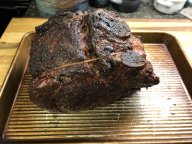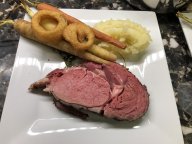My Italian heritage causes us to follow the "7 fishes" style of Christmas eve dinner, but for many a juicy prime rib roast is the meal of choice. If you're looking to smoke one in your RT this year but maybe feel a bit intimidated, or haven't been as pleased with your results in the past, here's a terrific and detailed recipe from the folks at ThermoWorks.
In my area I've been able to buy prime grade, boneless ribeye roast at Sam's Club, currently at around $18/lb
In my area I've been able to buy prime grade, boneless ribeye roast at Sam's Club, currently at around $18/lb


